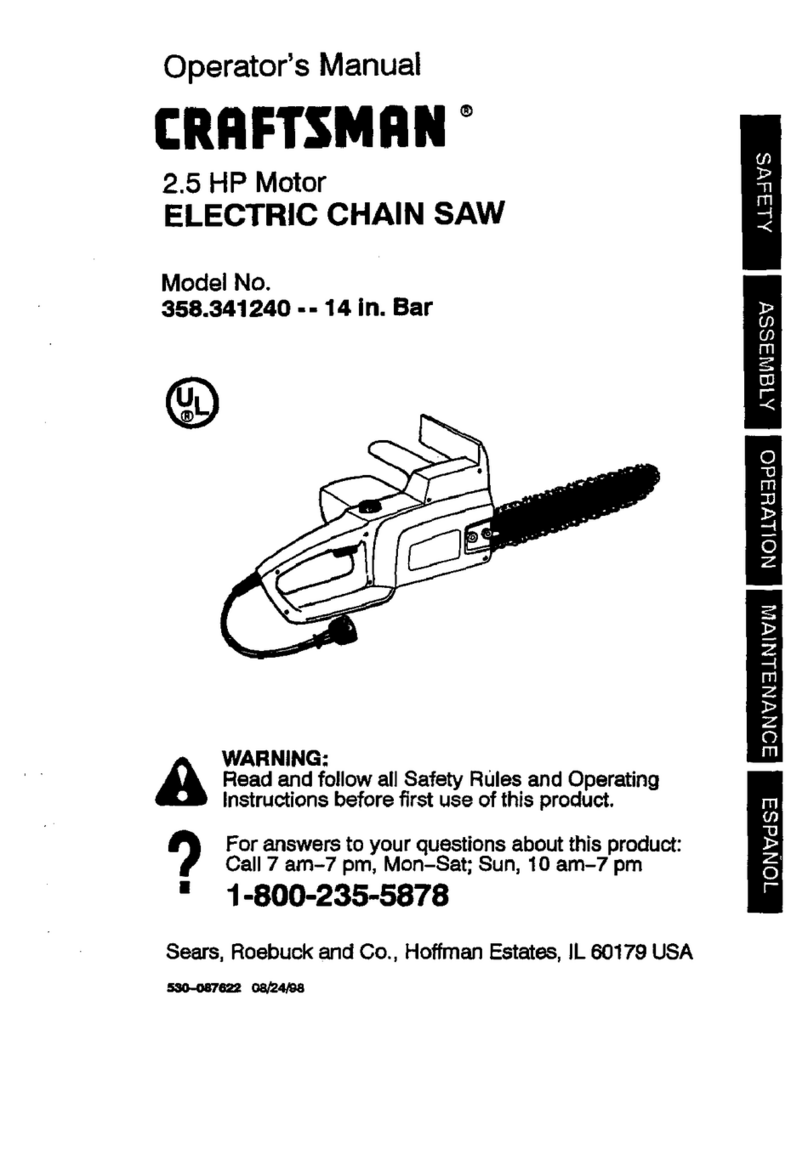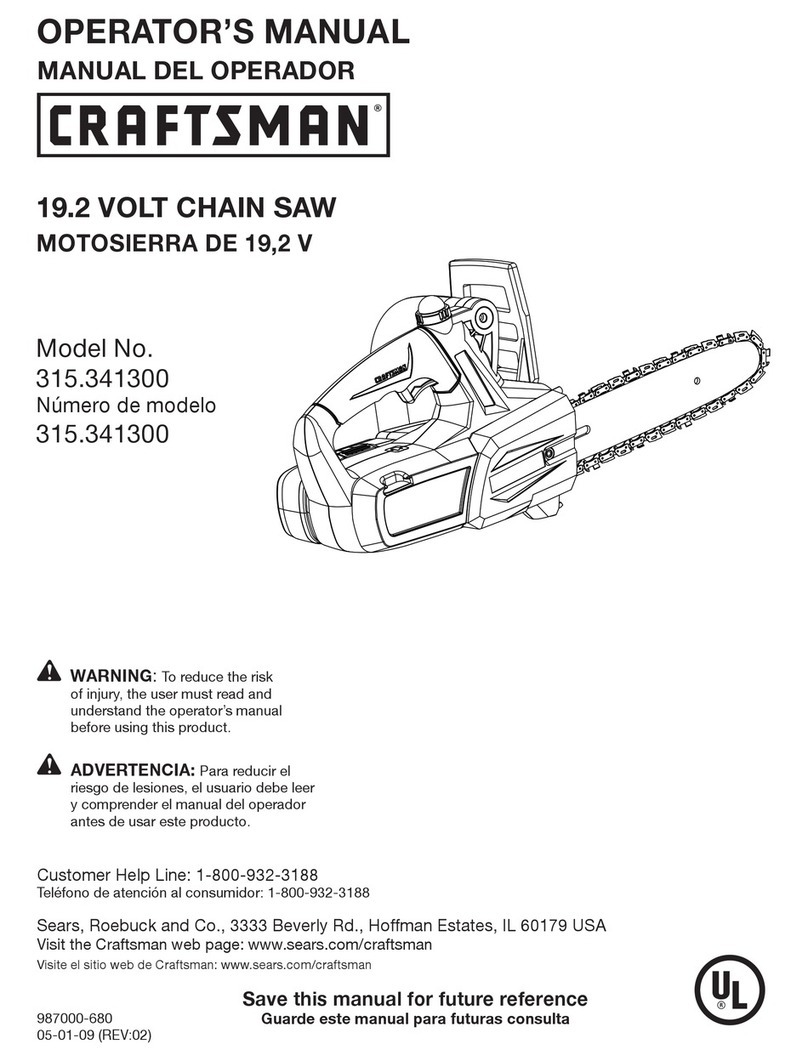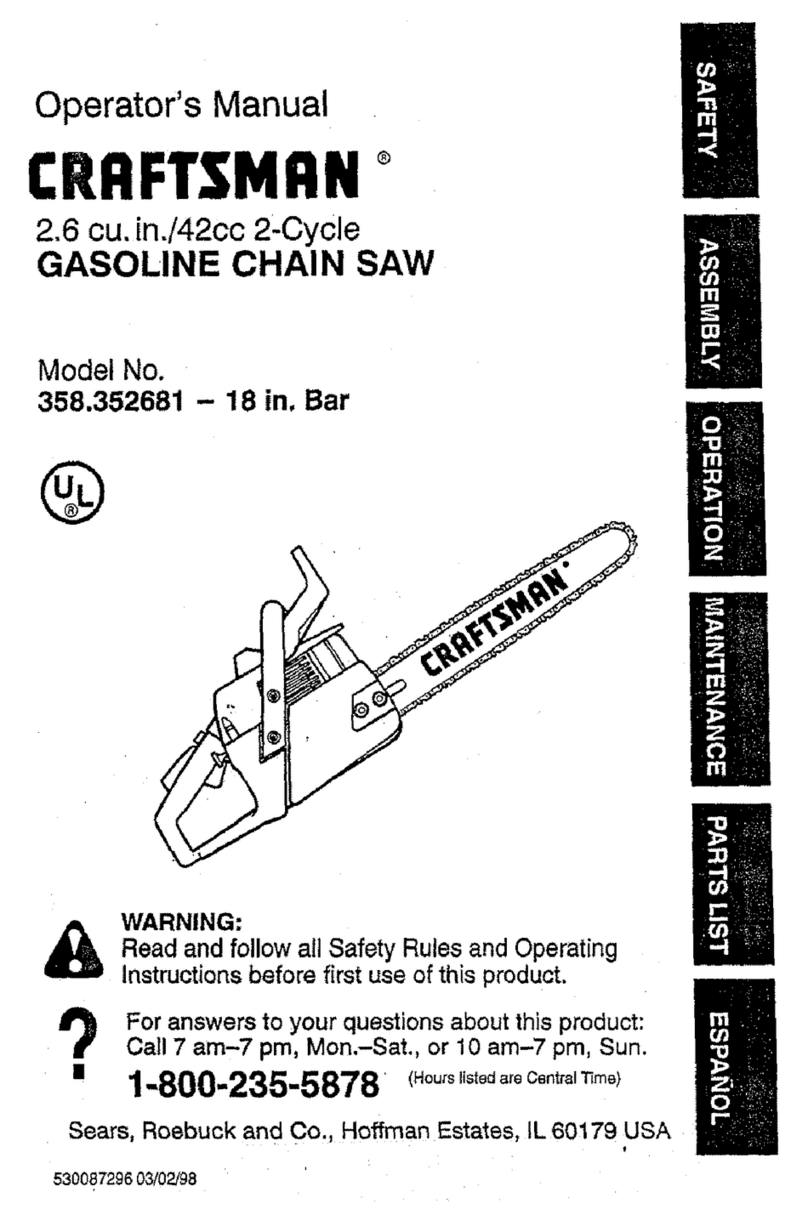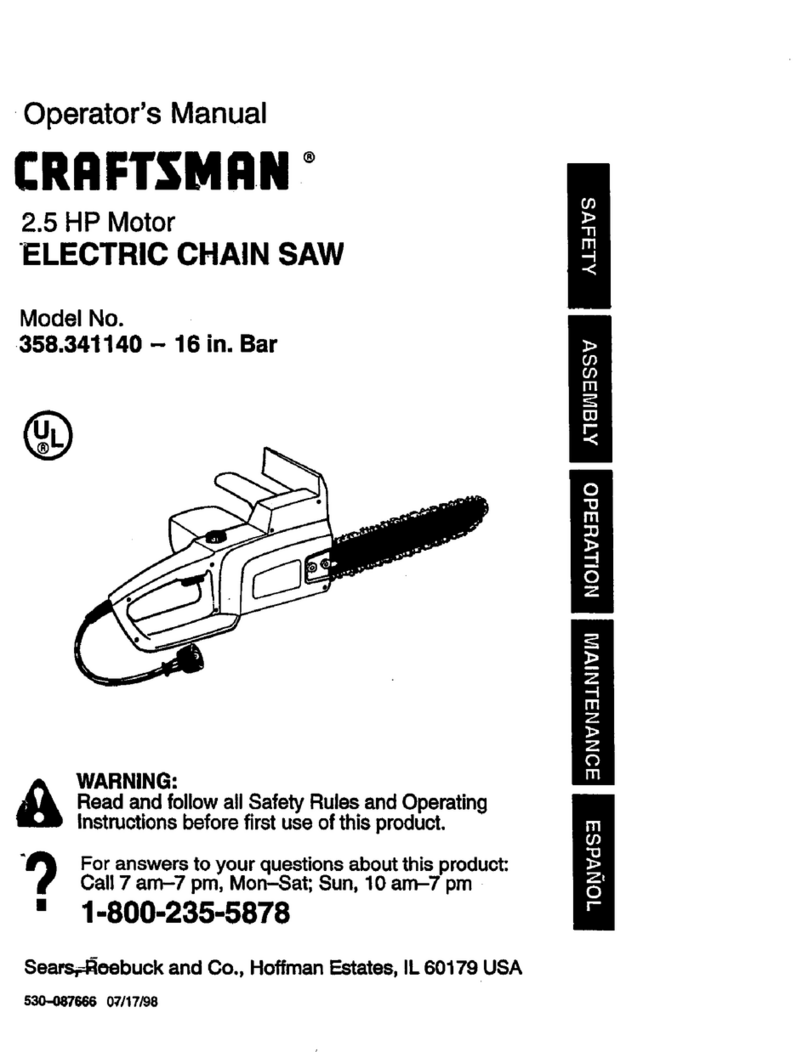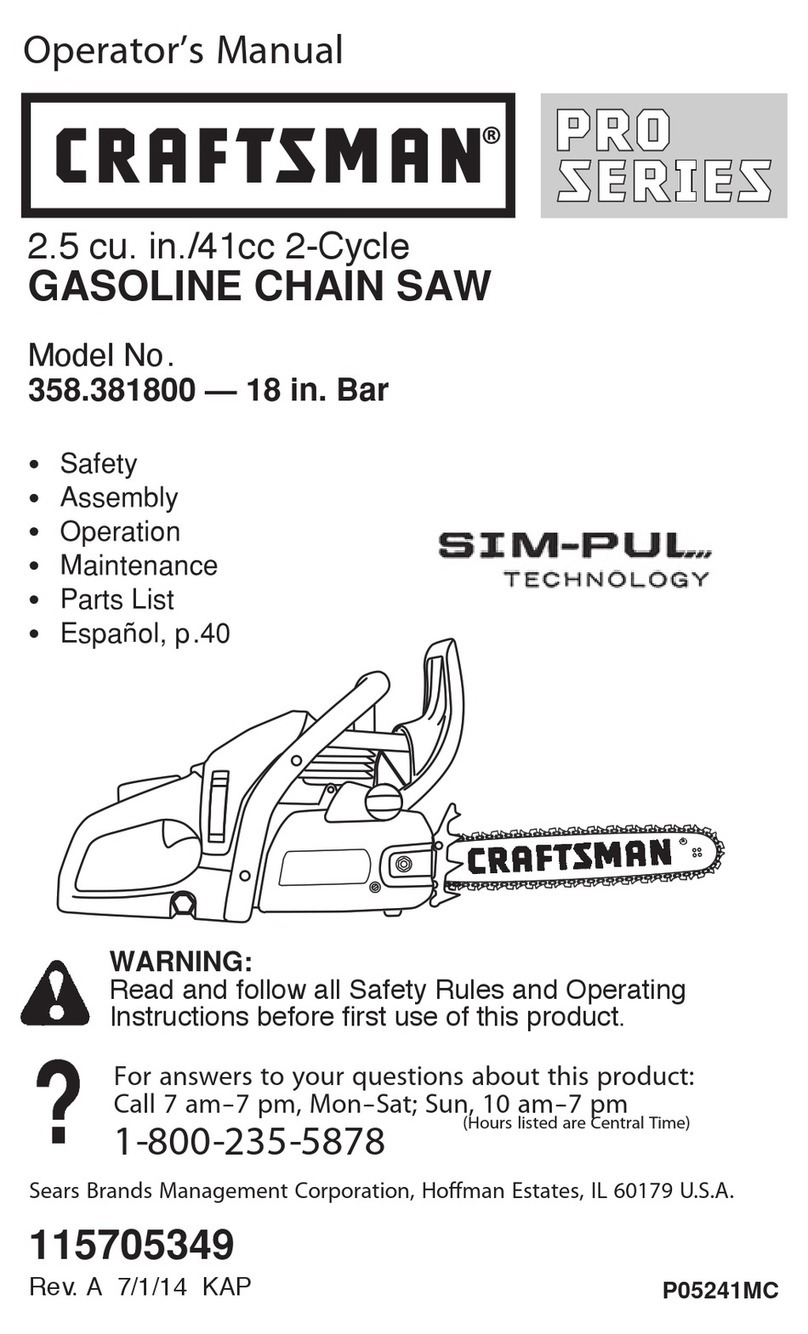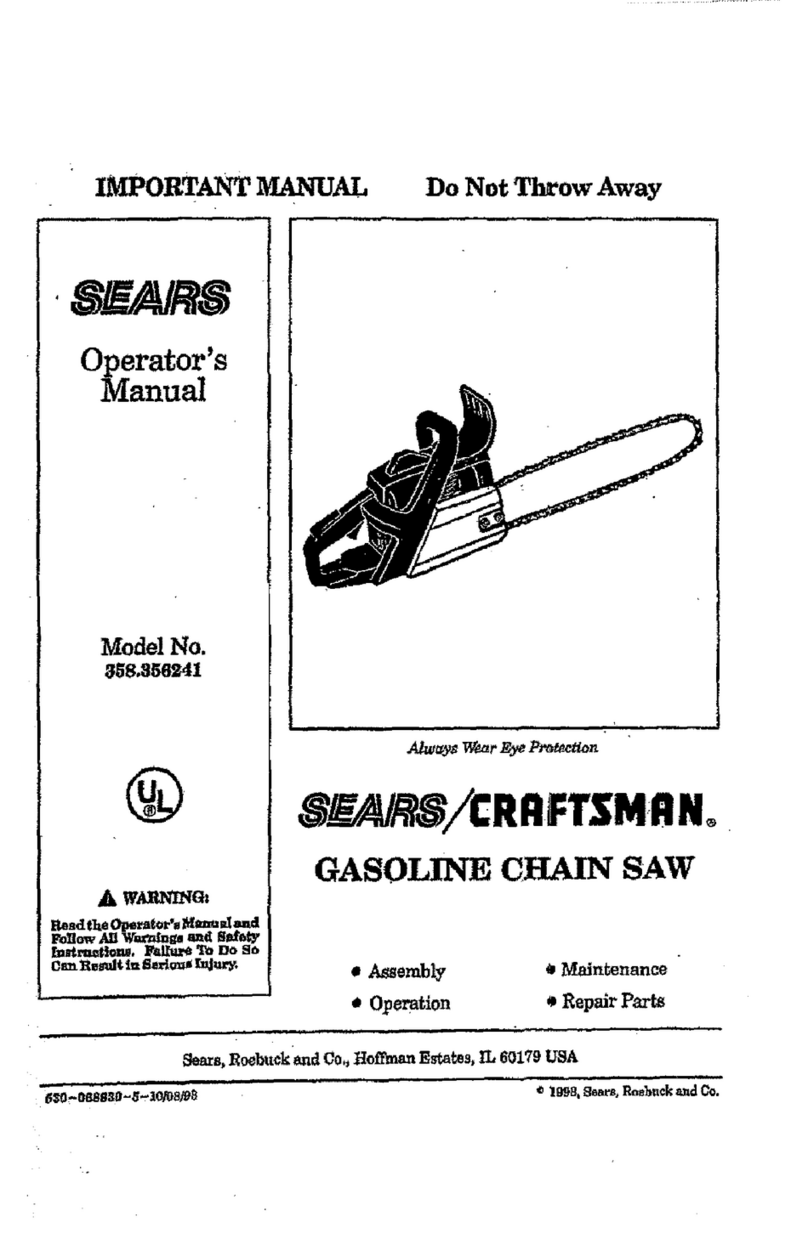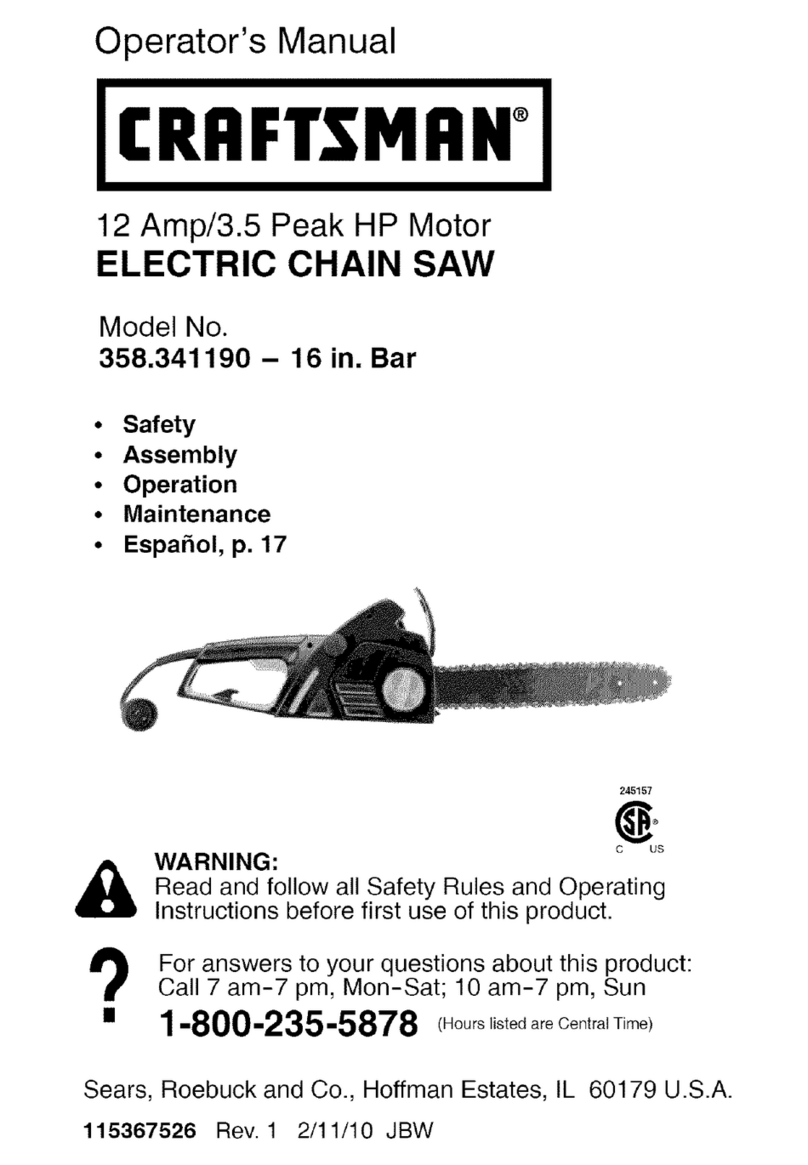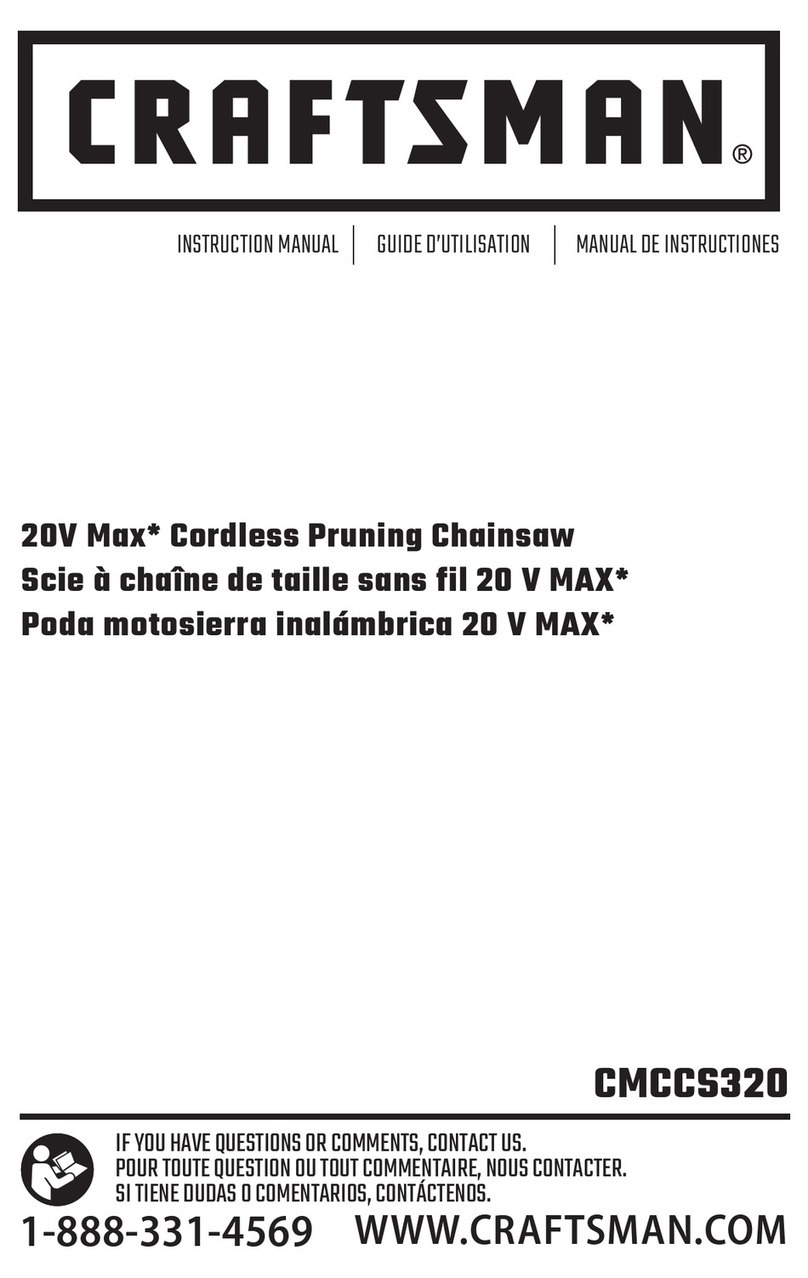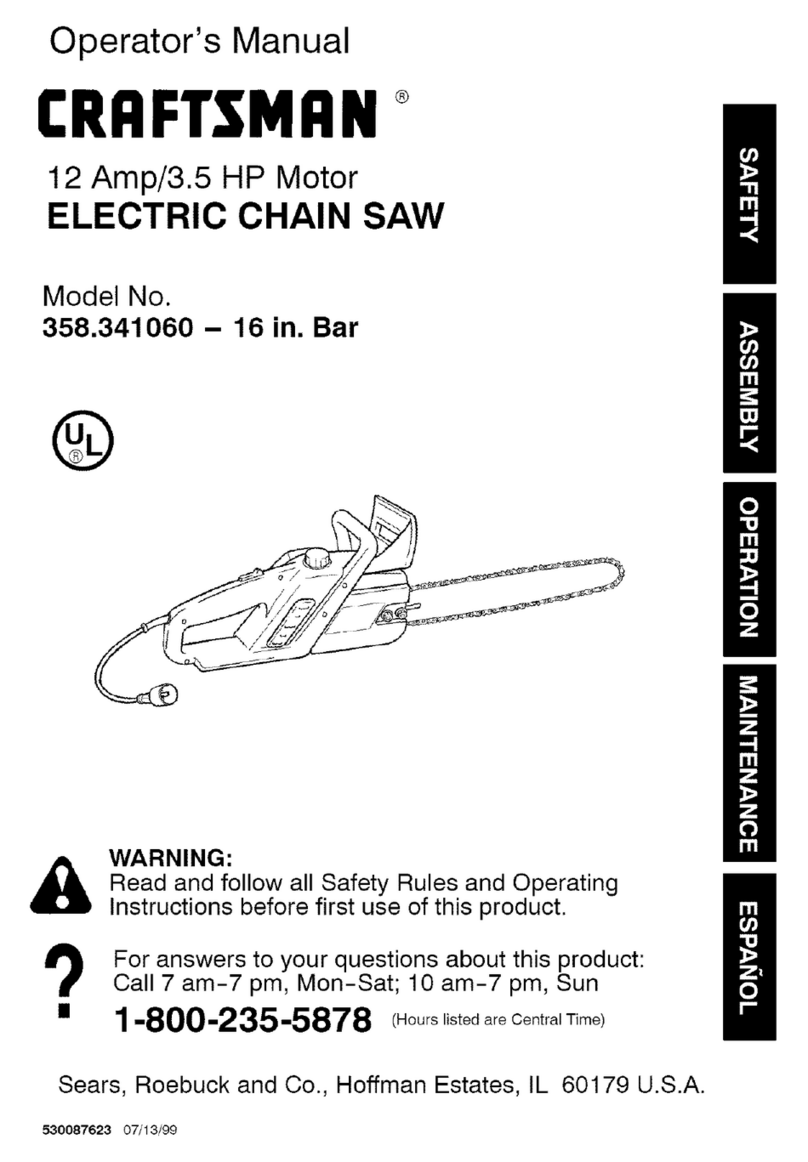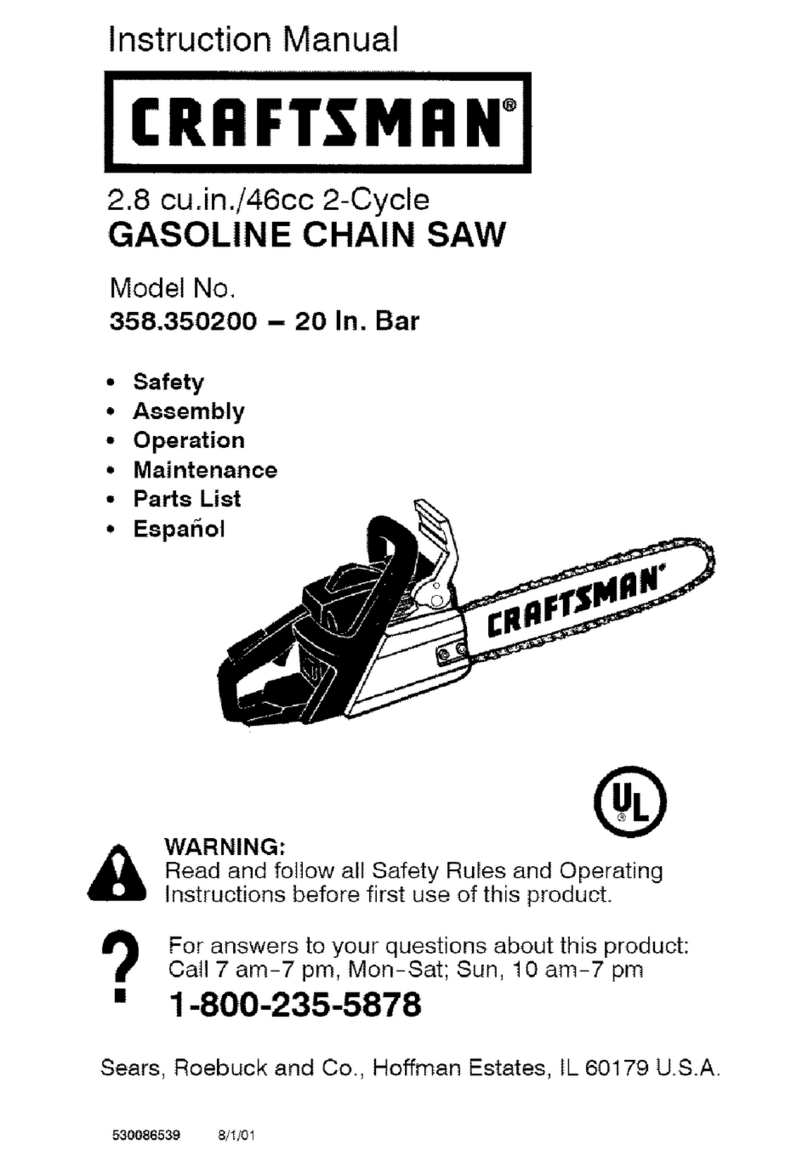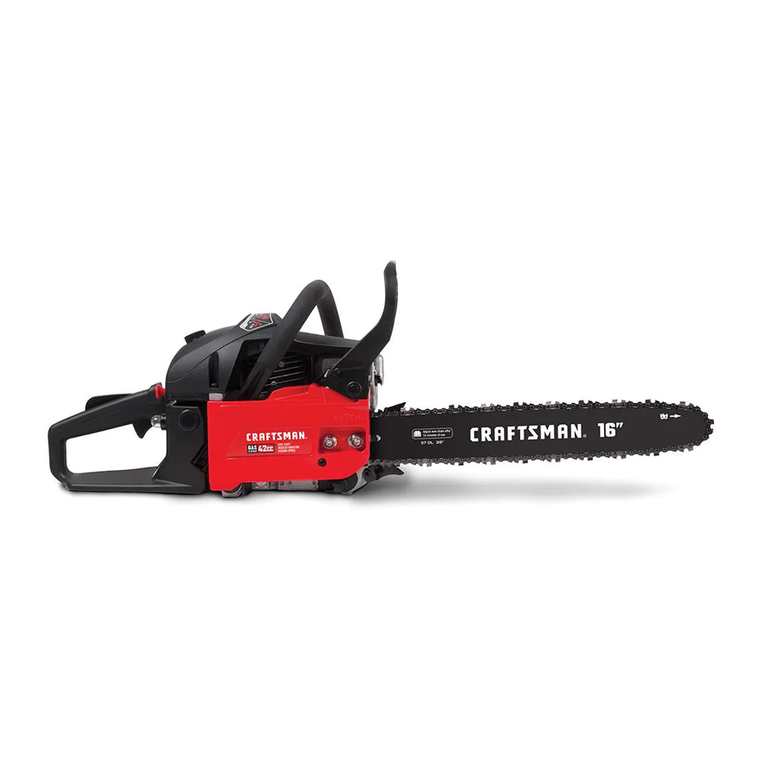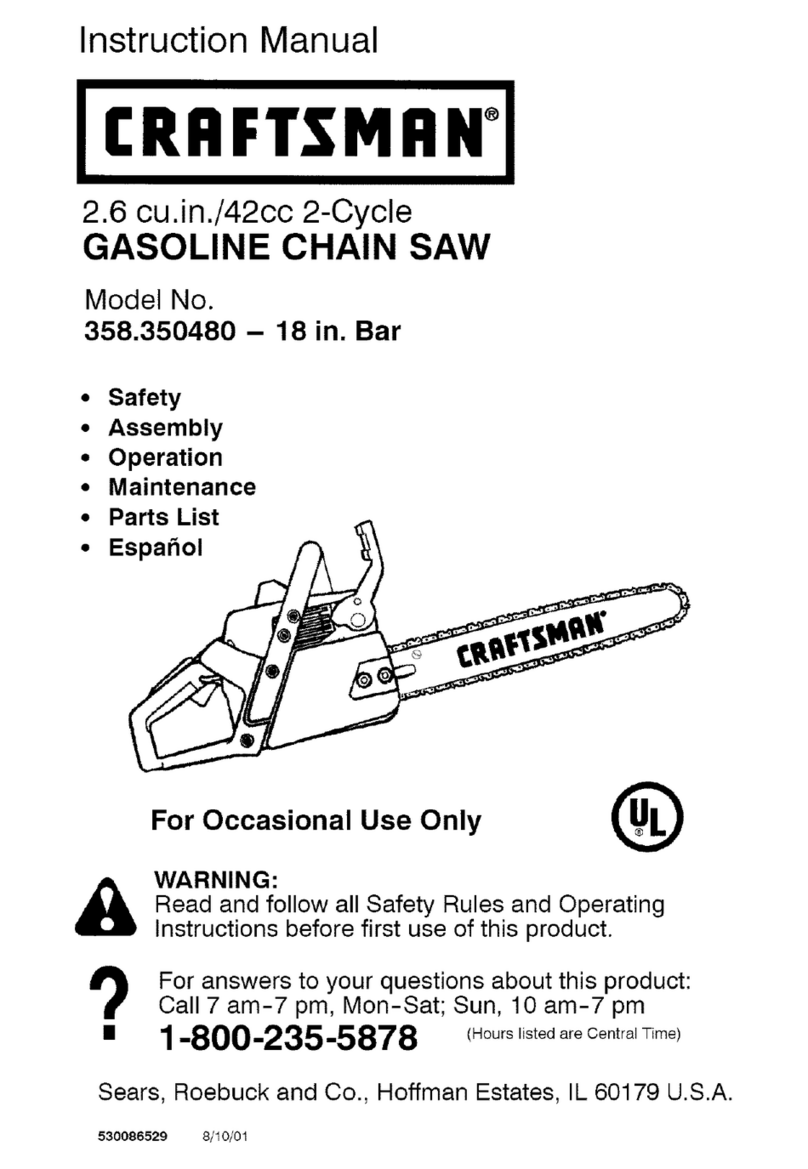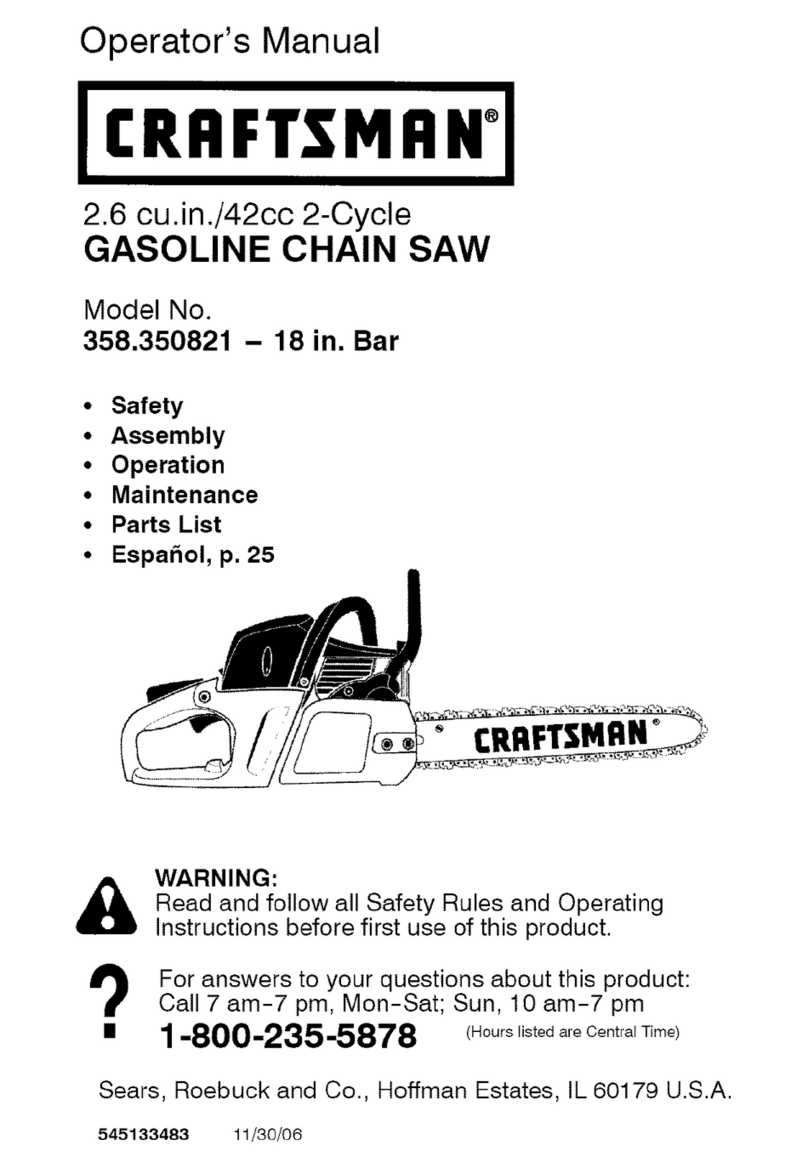SAFETY RULES
Never Reverse
Hand Positions Thumb On
Under Side Of_
Handlebar
Elbow
Stand To
The Left
Of The Saw
I
t!
Figure 4
REDUCE THE CHANCE OF KICKBACK
iRecognize that kickback can happen. With a basic
understanding of kickback, you can reduce the etement
of surprise whichcontributesto accidents.
Never let the movingchain contact any object at the
tip of the guide bar.Figure 2
Keep the workingarea free from obstructions sucn as
othertrees branches rocks fences, stumps, etc Figure
3 Eliminate or avoid any obstruction that your chain
could hit while you are cutting through a particular logor
branch
•Keep your chain sharp and properly tensioned. A
loose or dull chain can increase lhe chance of kickback
to occur Follow manufacturer's chain sharpening and
maintenance instructions Check tension at regular inter-
vals with the engine stopped, never with the engine run-
ning. Make sure the bar clamp nuts are securety tight-
ened after tensioning the chain.
• Begin and continue cutting at full throttle, If thechain
is movingat a slower speed, there is greaterchancefor
kickback tooccur
oCut one log at a time.
•Use extreme caution when re-entering a previous
cut,
Io not attempt plunge cuts.
Watch for shifting logs or other forcesthat coutd close
a cut and pinch or fall _ntochain_
Use the Reduced-Kickback Guide Bar and Low-
Kickback Chain specified for your saw
i i I I Ill"ll'l I'm I'llllll'l ,;;;,,
MAINTAIN CONTROL
• Keep a good, firm grip on the saw with both hands
when the engine is running and don't let go. Figure4
A firm grip can neutralize kickback and help you maintain
control of the saw Keep the fingers of your left hand
encirclingand your left thumb under the front handlebar
Keep your right hand completely around the rear handle
whether you are right handed or left handed Keep your
left arm straight with the elbow locked.
,Position your left hand on the front handlebar so it is
in a straight line with your right hand on the rear han-
dle when making bucking cuts. Figure 4. Never
reverse rightand left hand positionsforany type of cut-
ling
•Stand with your weight evenly balanced on both feet,
°Stand slightly to the left side of the saw to keep your
body from being in a direct line with the cutting
chain, Figure4
•Do not overreach. You could be drawnor thrownoffbal-
ance and lose controlof the saw
•Do not cut above shoulder height, It is difficult to
maintain controlof saw above shoulder height.
UNDERSTANDING REACTIVE FORCES
Pinch-Kickback and Putt-ln occur when the chain is
suddenly stopped by being pinched, caught, or by con-
tacting a fore=gn object in the wood. Thisstopping ofthe
chain results in a reversal of the chain force usedto cut
woodand causesthesaw to move in the oppositedirection
of the chain rotation Either reaction can result in toss of
control and possibleserious injury.
•Pinch-Kickback
- occurs when chain on top of guide bar is suddenly
stopped
-rapidly drives saw straight back toward operator_
° Pull-In
- occurs when the chain on the bottom of the guide bar
is suddenly stopped
- pulls the saw rapidly forward
KICKBACK SAFETY FEATURES
_WARNING
THE FOLLOWING FEATURES ARE INCLUD*
ED ON YOUR SAW TO HELP REDUCE THE
HAZARD OF KICKBACK; HOWEVER, SUCH
FEATURES WILL NOT TOTALLY ELIMINATE
THIS DANGEROUS REACTION. AS A CHAIN
SAW USER, DO NOT RELY ONLY ON SAFETY
DEVICES.YOU MUST FOLLOW ALL SAFETY
PRECAUTIONS, INSTRUCTIONS, AND MAIN-
TENANCE IN THIS MANUAL TO HELP AVOID
KICKBACK AND OTHER FORCES WHICH
CAN RESULT IN SERIOUS INJURY.
Reduced-Kickback Guide Bar, designed with a smelt radius tip which
reduces the size of the kickback danger zone on the guide bar tip.
Figure 5 A Reduced-Kickback Guide Bar is one which has been
demonstrated to significantly reduce the number and seriousness of
kickbacks when tested in accordance with ANSI B1751-1991
•Low-Kickback Chain, designed with acontoured depth gauge and guard
link which detlect kickback force and allow wood to gradually ride into
the cutter Figure 5 Low-Kickback Chain is chatn which has met
kickback performance requirements of ANSi B175 1-1991 when tested
on a representative sample of chain saws below 38 cubic inch dis-
placement specilied in ANS_ B175 1-199I
-4-
• Handguard, designed to reduce the chance of your left hand contacting
the chain if you_"hand slips off the front handlebe_t
•Position of lront and rear handlebars, designed with distance between
handles and "in-line" with each other The spread and "in-line" position of
the hands provided by this design work together to give balance and
resistance in controllingthe pivot of the saw back toward the operator if
kickback occurs.
*ANSi B175 1..1991 - Safety requirements for gasoline powered chain
saws as set by the American National Standards Institute, lnc,
Standard B175 1-1991
e_uced Kicld_¢k Small
Symm_tdc._l Guide ettt Rsdius Tip
Symmet_cal L_ge
Guide Br_r Radius 33p
Contoured
Depth G_uge
_P""*""-_ Guard Ltnk
KickbaCk Force
Ch_iLow"P'lc_gt_< _ To Grac_ualfy Rid_
_ntoCu_e_
I_"_-_ Can Oi:_ltucl
"_"-.,.F"r _teriat
Ch_n W_thHig_
K_cld_8ckP_ent_el
Figure 5
Figure 5


